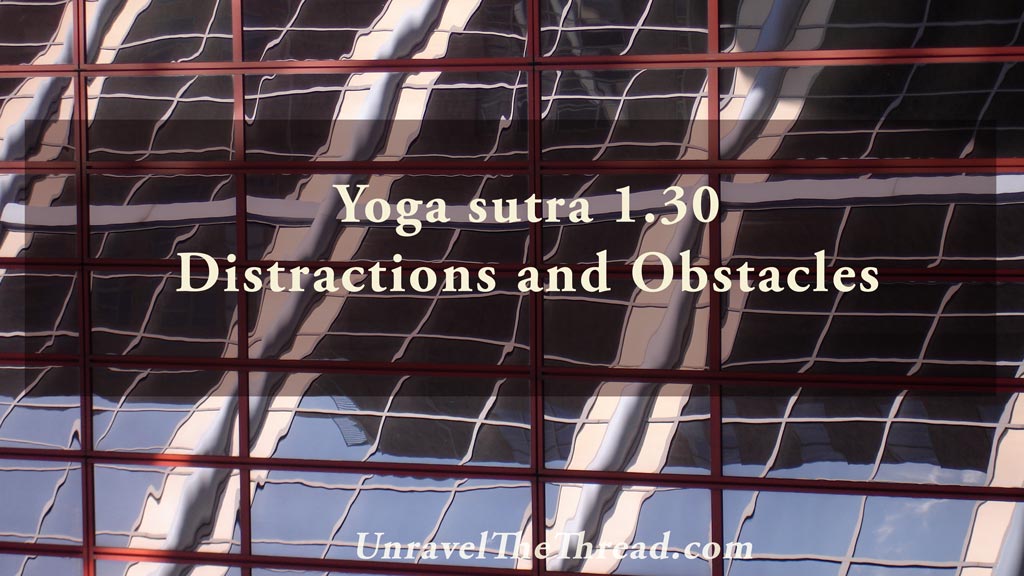
1.30 Distractions and Obstacles
October 18, 2019
1.32 Single pointed focus
November 1, 2019
1.30 Distractions and Obstacles
October 18, 2019
1.32 Single pointed focus
November 1, 20191.31 Symptoms of distractions and obstacles


1.31 The symptoms of the distractions include: distress (duhkha), despair, suffering, trembling and abruptness in breathing.
This verse explains that the symptoms of an obstacle or distraction manifest at the mental, emotional and physical levels. They include pain, distress, feeling disheartened and hopeless, unsteadiness, shakiness and uneven breathing. Feeling these symptoms is an indication that there is something that requires your attention. Rather than seeing the symptoms as shortcomings, it is more useful to recognize these symptoms as teachers offering you a pathway to address something that is creating disharmony. These distractions and obstacles test your resolve, and their symptoms offer you clear feedback that you can use to inform your actions. Remember, you are always in charge of your life experiment. From one moment to the next, you are constantly choosing what to do with the feedback you are receiving. Some of those choices are conscious, while others are unconscious. Whatever your choice, every action is part of a continuous cycle. If something is coming your way, even when you choose to ignore it or avoid it, it will find you and, quite possibly, the symptoms and feedback will become even louder to prompt you to act intelligently.
Remember that yoga is a practice of removing whatever obstacles keep you from being with what is unconditionally. Patient persistence in your practice helps you uncover inefficiencies restricting your optimal function at the physical, mental and emotional levels. In addition to reviewing each one of these nine obstacles as you did in the previous verse, you may find ways to decrease or remove these obstacles and distractions by engaging with the following questions: Is there physical, mental or emotional dis-ease? Is your pain increasing or decreasing? Does one distraction generate further disturbances and discomfort? How is your outlook: hopeful or hopeless? Are you complaining more? Are your movements graceful and smooth, or shaky and abrupt? Is your breath steady and continuous, or labored? Are you content?
As usual, as you explore your internal environment, remember that whatever is happening is valid, because you are feeling it. You can pause to bring your awareness to what is happening, then feel clearly what is happening without trying to make it into a drama or story so that you can respond consciously (Pause-Notice-Respond). This is one way of making intelligent decisions so that you can change direction when it is needed. Then you can feel the effects of your actions to verify if the change had the results you desired. Even when your actions decrease your current level of anxiety, pain or agitation, you’ll probably notice, sooner or later, that you keep reverting to the way of being you have grown accustomed to. Recall that this is a sign that your practice is working, because you are becoming better at noticing how you feel and because you can perceive with greater clarity the connections between stimuli, actions and reactions. This is where no strain, no struggle and no self-judgment can help you move forward without agitation. In the next verses, you will find specific ways to address the obstacles and distractions listed in the previous verse and the symptoms outlined in this sutra.
As usual, one more way of exploring the meaning of this sutra is by chanting it.
You can choose to chant it in its traditional form with all the words coming together:
1.31 duḥkhadaurmanasyāṅgamejayatvaśvāsapraśvāsāḥ vikṣepa sahabhuvaḥ
दुःखदौर्मनस्याङ्गमेजयत्वश्वासप्रश्वासाः विक्षेप सहभुवः ॥३१॥
Another option is to chant each word in the sutra individually:
- duḥkha
- daurmanasya
- aṅgam
- ejayatva
- śvāsa
- praśvāsāḥ
- vikṣepa
- sahabhuvaḥ
Unravel the thread is now available as a book!
If you find Simple-Yoga.org and Unravel the thread useful, consider supporting my labor with a donation, you may also donate using PayPal or Venmo. Thank you!